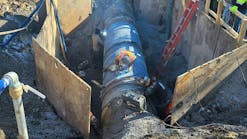Extending the life of the LVVWD distribution system
The Las Vegas Valley Water District (LVVWD) has been delivering quality, reliable drinking water to one of the world’s most dynamic desert communities for more than 60 years. A not-for-profit utility, LVVWD began providing water in 1954 to a service area of around 45,000 residents. Over the past 65 years, through periods of extraordinary growth and community development, LVVWD has been building and responsibly maintaining the city’s water delivery system, serving customers and using sustainable technologies such as solar power and alternative-fueled fleets to increase efficiencies and manage the costs of water delivery in the desert.
Strategically situated throughout the valley today are 79 reservoir basins and tanks that collectively hold nearly a billion gallons of water and 54 pumping stations with the capacity to move more than one million gallons of water per minute. LVVWD manages this complex water distribution system to deliver water to more than 1.5 million people in Las Vegas and surrounding areas.
The vast labyrinth of more than 6,500 miles of water mains and service lines — ductile iron, steel, cast iron, copper tubing, and C900 PVC — connect the community’s water supply to nearly 400,000 homes and businesses.
High Stakes
While the network of underground pipelines is carefully monitored using one of the most sophisticated SCADA systems in the world, LVVWD was unable to pinpoint the cause of water pressure transients in its distribution network.
Transients in the network are caused by changes in the velocity of water flowing through the pipe — from an operational change like a pump starting/stopping or a valve closing — and are a persistent problem in most water distribution systems. Over time, transients degrade the interior of the pipe, causing flexing and erosion that reduce the life of the pipe.
The disruption caused by water main breaks can be devastating to any community, and especially one that relies heavily on tourism. The stakes are high: A water main break in a congested traffic artery requires an all-hands-on-deck approach, 24 hours a day until it’s fixed. Minimizing pressure transients in the network extends the life of the pipe. If there are multiple transients each day, every day, then eventually, that pipe will fail. It may take 10-20 years, but if it happened to be buried under a four-lane roadway down the Las Vegas Strip, the disruption would be significant.
The LVVWD’s eight-person Asset Management team, part of the Infrastructure Management department, includes engineers, technicians, and a supervisor and also supports sister utility Southern Nevada Water Authority, the wholesale water supplier for the greater Las Vegas metropolitan area. The team estimates water loss, energy costs, and asset degradation for both utilities, assigning costs and determining the best time to maintain, repair, and replace assets. A large part of the team’s job is solving problems, identifying the source of different issues each day, including pressure transient analysis.
So, when three main breaks occurred in close proximity within a residential area in 2015, the LVVWD turned to the Asset Management team to understand why. The District’s state-of-the-art SCADA system, which shows 8,000 points of data every minute, indicated that pressure transients were occurring but could not provide more specific data. Transients can happen in a fraction of a second and could easily be missed between readings. The team needed more detailed information.
Doubling Down
A resort destination in the middle of the Mojave Desert, Las Vegas has become a region of proven first adopters, attracting technology that effectively addresses water resource management and sustainability. The non-profit WaterStart was established in 2013 to provide channels for innovative solutions-based technologies to reach the market. In partnership with WaterStart, LVVWD pilot tests the emerging technologies in real-world conditions, providing feedback as needed on the technology’s performance. Through this partnership, LVVWD was introduced to Syrinix, makers of intelligent water and wastewater pipeline monitoring equipment.
The user-friendly technology seemed easy to install with nearly instant actionable data, and in March 2016, LVVWD deployed 10 Syrinix PIPEMINDER smart pressure monitors around the Las Vegas valley to evaluate the technology and gain insights into pressure transient conditions. These devices, about the size of a paperback book, were installed on 1/4” service connections and fire hydrants. The units were configured to monitor continuously at 128 samples per second and to summarize the minimum, mean and maximum pressure. The device takes a pressure reading, transmits the pressure data through cellular signals to RADAR, Syrinix’s cloud-based portal, for data analysis. Available online and accessible on tablets and phones, RADAR provides rich data analysis and reporting on demand. Before deploying the PIPEMINDER units, there was no way for LVVWD to accurately measure a transient; however, with technology like this, any changes in pressure could be monitored in hundredths of a second.
After a week of monitoring, there were clearly visible transient patterns. When the recorded transient data was overlaid with the utility SCADA system data, it was immediately visible that the transient activity correlated with valve operation activity within the network.
With this level of data, LVVWD could fully understand what was going on in the network and was able to make adjustments to its operations that would reduce the transients, mitigate the risk of further breaks, and extend the life of its distribution system. Specifically, by slowing down the speed of the valve opening, LVVWD was able to reduce the severity of the transient. The maximum observed pressure was reduced by over 50 percent, from 323 psi to 160 psi, an operating pressure much closer to the 150 psi rating of the PVC pipeline.
Following the successful pilot testing coordinated with WaterStart, LVVWD deployed additional Syrinix PIPEMINDER smart pressure monitors within its water distribution system. With enough pipe to go a quarter of the way around the globe, LVVWD choose to move its devices from place to place along the network to analyze various sections of its water system. For example, if there’s an indication that a transient might be exciting the network, they can plug the device into a nearby hydrant. Within a day, they can see highly accurate results that are graphed to easily identify transient conditions. By comparing the pressure data from all the PIPEMINDER monitors, it is possible to triangulate the source of the transient event and this can be further verified by looking at SCADA data during the same observed time period. Comparing times of valve operations, for example, alongside that of the transients detected, means cause and effect can be identified. Then the real work begins; adjustments to operations, like how a valve or pump is managed, can be made to calm the network. Having highly accurate data enables those adjustments.
Big Wins
Often, a problem can be mitigated by simple changes in operation without the need for costly new equipment. LVVWD’s Asset Management team analyzes the problem to understand the cause and effect. Once they’ve determined the actual cause, they find changes that can be easily implemented to rapidly solve the transient conditions without capital expenditures.
LVVWD has 54 pump stations and every time pumps start or stop, they create a pressure transient, usually less than 10 moderately high transients per day. Under normal operations, LVVWD has mitigated almost all of the severe transients and now focuses on moderating the lower magnitude transients.
It could take years to see the full results of the Asset Management team’s efforts. But by moderating the impact of a transient on the pipe system now, they increase the likelihood of getting a full 50 or even 100 years of life out of the pipeline. By extending the life of the distribution system, they’ve postponed the day when the pipe needs to be replaced.
Pipes are going to break; they are going to need to be replaced. It’s a very disruptive, time-consuming, and expensive project. By using highly accurate data to make operational changes that calm the network, that pipe might get a transient once a day instead of multiple times a day. Over time, this enables LVVWD to push out pipe replacement for many years. Using advanced technology like Syrinix, the LVVWD is giving the Las Vegas community the best chance of extending the life of the distribution system to its fullest potential. WW







